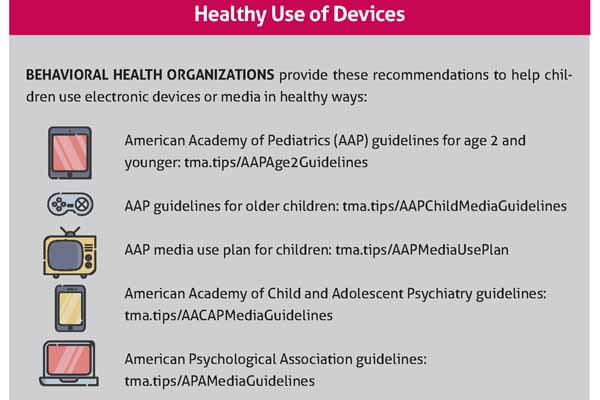
When Dallas adolescent medicine specialist M. Brett Cooper, MD, talks to his young patients in the exam room, most pay attention. But some kids find their smartphones so irresistible that Dr. Cooper is just an afterthought.
“This has been a growing problem, at least with my adolescents in clinic,” he said. “They really struggle during the office visits to put their phone down and not look at it at least once during that visit. Parents of these patients often have to be, like, ‘Hey, the doctor’s talking to you,’ because they’re just sitting there texting away or whatever they’re doing on their device while I’m trying to ask them questions.”
The overuse of electronics by young people has several causes, including the near universal ownership of sophisticated devices among U.S. adolescents. In 2018, 95% of teens reported having access to a smartphone, and 45% said they were online “almost constantly,” according to the Pew Research Center.
COVID-19 greatly boosted technology use by everyone. When the pandemic spread nationwide in March 2020, schools and employers switched to online formats as people stopped interacting personally to prevent the spread of the disease.
Parents who before the pandemic limited children’s exposure to technology suddenly found themselves encouraging children to use devices more as the only way to interact with friends and do schoolwork, says Nhung Tran, MD, a developmental-behavioral pediatric specialist in Austin.
“Not only is our current generation of children undergoing this [social] experiment of growing up with easily accessible, affordable, portable electronics; we also had to use [those devices more] during COVID lockdown,” she said.
The pandemic showed that smartphones have several benefits, including their ability to educate and help people overcome isolation.
But too much screen time can lead to several potential medical problems such as difficulty sleeping, lack of exercise, and weight problems, according to the American Academy of Child and Adolescent Psychiatry. It also can lead to increased moodiness and poor self-image.
The overuse of electronic devices that entertain is nothing new, Dr. Cooper says. Previous generations documented television addiction, for instance. But not only is a smartphone more portable than a TV; it also offers far more opportunities for distraction – games, apps, social media, texting, and more. Most parents are not equipped to adequately anticipate the impact of a smartphone on their child, he says.
“We didn’t grow up with this technology, so a lot of parents don’t have good guidelines or expectations for how to do this,” Dr. Cooper said. “They watched how their parents parented them, and their parents didn’t have to deal with this.”
That’s why it’s important for families to have strategies for preventing or mitigating the overuse of devices among young people, Dr. Tran says. The games, social media, and other features on any phone are cleverly designed to prolong each viewer’s attention, and young people need to know how to handle that.
“It’s not the electronics that are the problem,” she said. “They are a part of our lives. It’s learning how to use them appropriately – learning how to use [a device] when you need it and learning how to turn it off.”

Addiction vs. healthy use
Just as most people who drink never become dependent on alcohol, most people who use a smartphone will never become addicted or even struggle with overusing the device, Dr. Tran says. But behavioral addiction – like the kind seen with gambling or video games – can develop when people use smartphones and other electronic devices.
Defining who is and is not addicted can be difficult. However, “behavioral science experts believe that all entities capable of stimulating a person can be addictive,” according to a 2012 study on behavioral addiction in the International Journal of Preventive Medicine. “And whenever a habit changes into an obligation, it can be considered as an addiction.”
Adults can develop addictive behaviors with their devices. But as devices have become more common and sophisticated, pediatric health professionals have grown increasingly worried about adolescents and younger children, Dr. Tran says.
“If you have a propensity for addictive behaviors with devices, then the concern is whether early introduction to devices will move that chronology along faster,” she said.
Parents looking to avoid either addiction or heavy use of electronics should start off by introducing devices to children slowly, she says. The American Academy of Pediatrics recommends children aged 2 and younger avoid most types of media use and that preschoolers should get no more than one hour of high-quality programming per day.
Older children and teens can use devices, but that introduction should be very gradual, Dr. Tran says. Consider starting off with a phone that simply makes calls at first. Once a child can use it responsibly, slowly add features such as texting and internet capacity.
“You don’t give them free rein [to use a device] and then discipline their misuse by pulling back,” she said. “This is a sure way to create conflicts. You start off with setting clear limits and boundaries and then expand them slowly when they show you that they can be trusted with it.”
For families who have already introduced electronics, a slow rollout may no longer be an option, Dr. Tran says. They should consider following programs like Turn It Off Today, which asks kids to put down their phones for brief periods each day and do something else with their time, like play sports or take part in school activities.
“You’re not exercising a muscle [by putting down the phone], but you’re exercising a very important process in your brain – a process of pausing and moving on,” she said.
That’s important because young people who overuse their phones behave in many ways like children with attention-deficit/hyperactivity disorder (ADHD) – even though they don’t actually have the disorder, she says.
“Kids who are overly used to electronics may not have ADHD – that’s something you’re born with,” she said. “But we’ve inadvertently caused difficulties with regulating attention much like a child with ADHD by making them think they can do several things at the same time. They may think they can listen, walk, eat, do homework, and look at their electronics simultaneously. But they may not be doing any of those things very well.”
Parents who ask kids to put down their devices should always suggest alternative activities in order to prevent meltdowns, says Dallas adolescent medicine specialist Drew Alexander, MD.
“You can pull back [the smartphone use], but you have to have a replacement,” he said. “And when you see frustration and anger [in a child who’s been asked to put down a smartphone], it’s because the adult hasn’t considered what to replace it with.”
Practicing putting down the phone has one end goal: to ensure that a child can walk away from his or her phone at any time without difficulty, Dr. Tran says. In many ways, it’s the same attitude most parents try to instill in children about candy.
“The idea is to look at the chocolate and go, ‘I don’t really need that right now,’” she said.
However, enacting these changes can be difficult. In some families, children already have developed an addiction and may need counseling. In other cases, low-income families often don’t have the time or resources for their kids to join a team or attend a camp.
But it’s vital to help young people understand how to put down a device at a young age.
“We have to teach them how to look at a [phone] app for what it is,” she said. “It’s enjoyment. It shouldn’t cause you to lose money. It shouldn’t cause an argument in your relationship. It shouldn’t interfere with your employment.”
Also, the devices are just going to become more sophisticated and more difficult for people to put aside, she says. As parents, today’s children will have to wrestle with the same problems and be able to find constructive solutions.
“If we’re [talking to] our kids about the addictive nature of their current mobile devices, I wonder what kinds of devices they’re going to [talk to] their kids about,” she said.
Tex Med. 2022;118(3):40-43
April 2022 Texas Medicine Contents
Texas Medicine Main Page